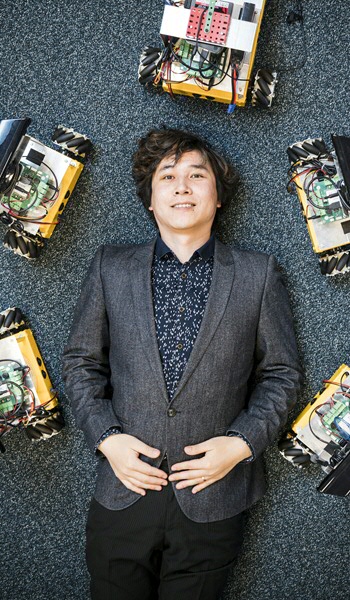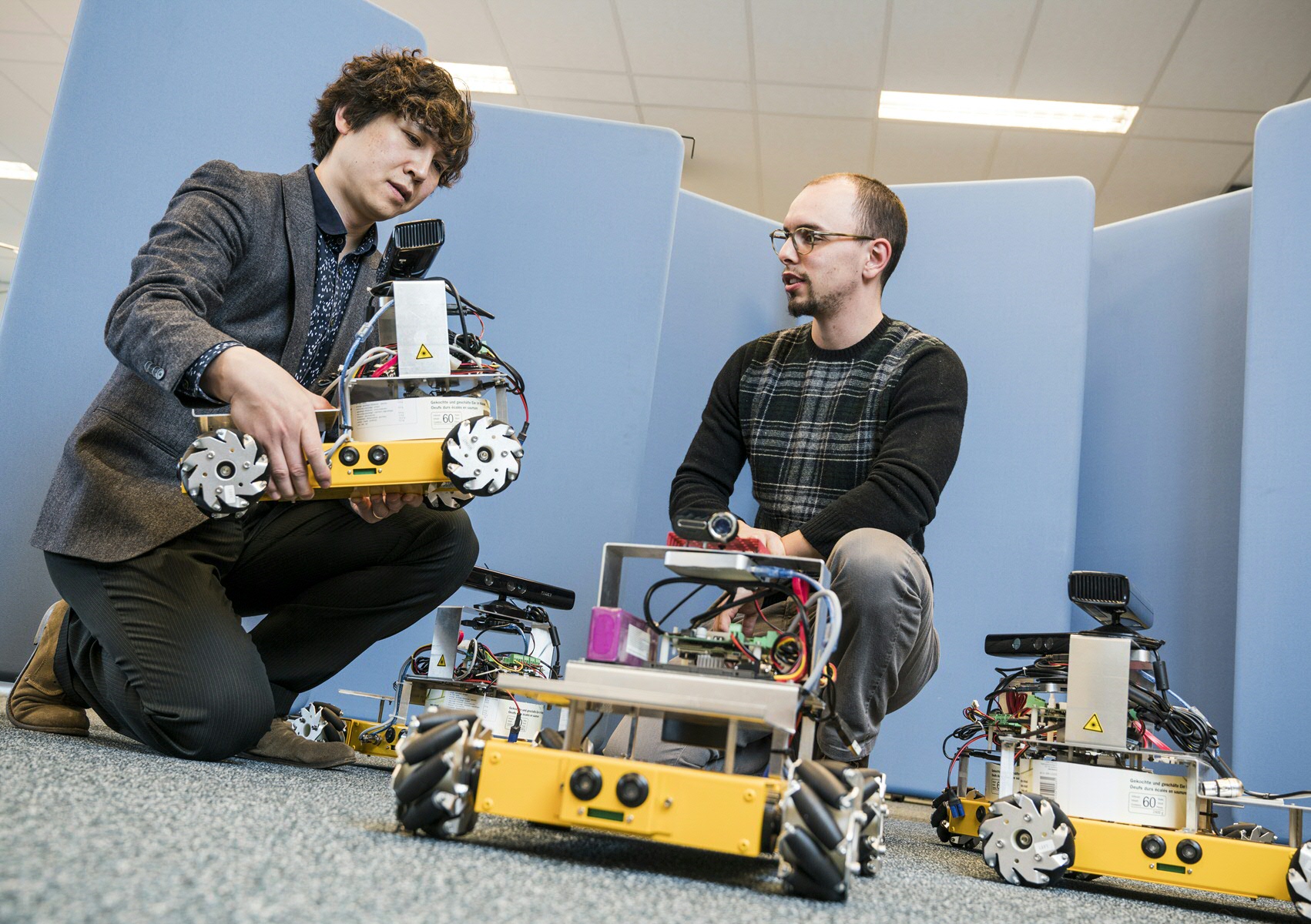Nature has the answer

Starlings and ants achieve with limited intelligence something that is too complex for even the smartest robots: working as a collective. This is why Professor Ming Cao likes to spy on nature.
Text: Sebastiaan van de Water, Photos: Bram Belloni
S ix robot fishes float aimlessly in a small swimming pool. They have been given a clear task but do not appear to be doing it. Even the presence of Professor of Networks and Robotics Ming Cao (41) in the lab does not spur them into action. What is going on? The fish have proven their swimming skills often enough. Two trophies in the cabinet behind the swimming pool bear witness to sterling performances at the robot water polo world cup. A video on YouTube shows what happens when you place such a robot fish in a pond with real fishes. Internal hinges, stabilizing fins and a rubber-like casing make the robot move through the water so realistically that real fishes do not flee from their plastic cousin but follow it instead in fascination. One thing is sure: these six robot fishes are excellent at swimming – as long as they choose to.
Swimming pool
The reason why they are not swimming now relates to an experiment that is being carried out in the swimming pool. There is a battery at the edge of the pool. The fishes are programmed to refuel from it: nutrient-rich food from their perspective. But the battery is blocked by an obstacle. The fish know that to push away the obstacle takes energy, perhaps more than they have. In theory, they could work together. Share the burden. But how can they coordinate that? They do not have the ability to consult with each other. They can only make the decision for themselves: am I going to be the first to try to push away the obstacle? Or should I wait for another fish to do it and benefit from that? Just as cyclists in the peloton don’t want to sacrifice themselves to catch up with a leader who has escaped from the pack, the robot fishes make a decision that is rational for the individual but irrational for the collective: they do nothing.

Autonomous performance
This experiment took place a year ago in the lab at the Faculty of Science and Engineering of the University of Groningen. ‘It illustrates one of the problems with robots’, says Cao, who is sitting in his office. ‘Researchers and engineers can’t seem to get groups of robots to work together properly. As soon as you try to upscale the individual algorithms, you start to run into problems. But getting robots to act as a self-regulating collective in the long term is crucial.’ Why? Imagine deploying 15 robot carts to explore an environment. This could be on Mars, the seabed or ground zero of a nuclear disaster. Each robot could be operated remotely by one person. ‘Highly inefficient. You want them to be autonomous’, says Cao. OK, option two then: a supercomputer could operate and coordinate the group as a whole. If you did this, the six fishes would definitely have pushed the obstacle away. ‘But a computer that constantly needs to simultaneously process all the sensory input and individual algorithms uses up an exponential amount of processing power. That’s unsustainable.’ But there must be ways to get robots that think individually to work together efficiently, says Cao. ‘Animals manage to do it after all.’
Ants
For a researcher who originally trained as an electrotechnical engineer, at Tsinghua University in Beijing, surprisingly enough Cao likes to talk about ants and honeybees. ‘That’s the paradox: they are all tiny animals with limited intelligence, but together they manage to achieve big things. One ant explores the environment, the other is responsible for food and yet another clears up the mess. This division of labour works really well. But how do they manage to coordinate this? There’s no collective brain, no leader who makes the decisions, no bureaucracy. But they manage to do what our most advanced robots, programmed by the best researchers, don’t. That’s why I like to gain inspiration from nature.’ Not that Cao pulls on his walking boots every Wednesday afternoon and, accompanied by his group of international PhD students, sets off into the Groningen countryside in search of ants. ‘No, I don’t think that would be an efficient division of labour’, he says. He points through the window to a large green building, Linnaeusborg. ‘I prefer to go there for answers.’ The bent shape of the building symbolizes the double helix of DNA. Here UG biologists study the behaviour of organisms. “Four million organisms populate our planet. Four million different solutions to the problems of staying alive”, as British biologist and broadcaster David Attenborough once put it.
Brilliant algorithm
For Cao, talking to biologists is like leafing through a book that contains all the answers. One interesting survival strategy, for instance, is the one used by starlings. When the summer starts to draw to an end, they cluster together in groups of hundreds or thousands at a time and give impressive daily air shows. Hungry eagles prefer to turn right at the next cloud than attack this dancing flock. The strange thing is that no starling has ever had to practise before joining in the dance. There is no choreographer, no leader. Just like with ants, the coordination appears to be almost spontaneous. How can that be? Cao: ‘A recent scientific article concluded that each starling follows two simple rules: each individual keeps track of six birds that are flying close by and tries to stay in the middle of these. If one starling is about to bump into another it brakes. That’s it.’ The collective performance is the result of a brilliant algorithm that thousands of individuals diligently follow.

Red teapots
‘For biologists such an insight represents the end of their research. Luckily, I’m an engineer’, Cao smiles. ‘For me it’s just the beginning.’ Armed with his knowledge of biology, psychology and sociology Cao retreats to his office. Among the red teapots and Chinese watercolours he spends the majority of his time translating the lessons from nature into mathematical models. These he distils into algorithms that could prove useful for robots. The final step is the big lab, where he and his staff freely experiment with all sorts of robots. This explains why three or four robot carts ride autonomously round the lab. Not crisscrossing, bumping into or cutting up each other but in neat formation. Thanks to simple sensors and algorithms. ‘Being able to ride in formation could prove very handy in warehouses, for instance, when transporting long beams or the triangular tailfins of an aircraft’ says Cao.
Black robot arms
Elsewhere in the lab black robot arms stand on a table. There are four of them, but it could easily be 400. Like starlings they are programmed only to take note of the closest arms and to copy their movements. Get one to move and within no time they all do the same, and this coordination does not need much processing power. They might not have managed to produce honey yet, but this is definitely the start of a self-regulating network. ‘We have also solved the problem with the robot fishes’, says Cao. ‘How? By giving them different personalities. In nature you also see that the tendency to take the initiative and follow others is not the same in all animals. Once we had incorporated this concept into their algorithms, we repeated the experiment numerous times. Now they did work together. Still without any communication between the fish. Fixed roles arose: leaders, helpers and freeriders. Coincidentally, leadership is a hot topic in biology. We do not just derive knowledge from other fields but add knowledge too. That’s the good thing about our multidisciplinary approach.’
Walking distance
Engineers can no longer just tinker away at machines, says Cao. ‘Those days are over. I try to teach my students that we must widen our focus. We need knowledge of artificial intelligence, biology, psychology and sociology to build successful robots. Luckily, experts in all the relevant disciplines work here in Groningen, within walking distance of each other. A considerable advantage over Delft or Twente, for instance.’
Humanoid robots
Although Cao never doubted Groningen professionally, privately it was a different matter. ‘My wife and I were used to Beijing and later on New York. When we moved into a small house on the outskirts of Groningen in 2008 it was a shock. Our neighbours were cows grazing. The quiet took a lot of getting used to. But we like it here now. It’s a good place for our daughters to grow up in. We’re staying, for now at least.’ And that is good for the UG. Because although Cao believes that we will soon have specialized robots, he believes that flexible, humanoid robots are a long way off yet. Let alone robots that brazenly connect different disciplines. To paraphrase American philosopher Elbert Hubbard: one robot can do the work of 50 normal people. But 50 robots cannot do the work of one extraordinary person.
This article has been taken from New Scientist.
More news
-
11 December 2025
Stormy planets and an unexpected atmosphere
-
09 December 2025
University of Groningen Professor at COP30: ‘There is always drama’
